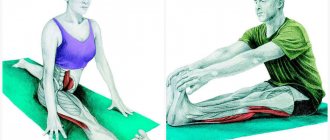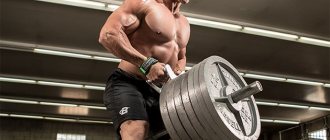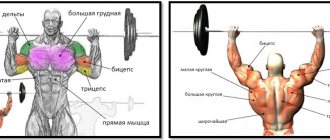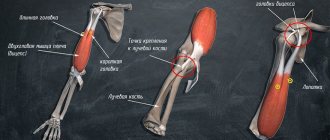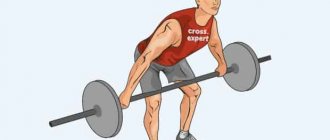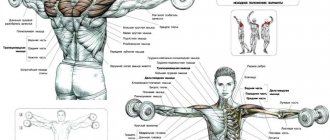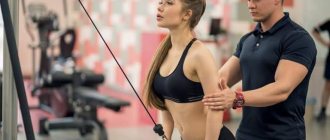Author: Timko Ilya - the ruler of the entire site and fitness trainer | more details >> Rod. 1984 Trained since 1999 Trained since 2007. Author and creator of the site tvoytrener.com. CCM in powerlifting. Champion of Russia and South Russia according to AWPC. Champion of the Krasnodar region according to IPF. 1st category in weightlifting. 2-time winner of the Krasnodar Territory championship in t/a. Author of more than 700 articles on fitness and amateur athletics. Author and co-author of 5 books.
Place in the author rating:
out of competition
(become an author) Date: 2012-05-29 Views: 1,589,029 Rating: 4.9
| All articles by the author >> | Medals articles >> |
Articles are loading...
| Article medals: | article in TOP 50 | more than 1 million views |
Why medals are given to articles:
| Bronze medal: | |
| 1. The article is in the TOP 100 2. The article has more than 3. The article has more than 100 | |
| Silver medal: | |
| 1. The article is in the TOP 50 2. The article has more than 3. The article has more than 500 | |
| Gold medal: | |
| 1. The article is in the TOP 10 2. The article has more than 1 3. The article has more than 1,000 | |
Main muscles - anterior delta Additional - middle delta and triceps Difficulty - medium
Load by muscle group
The load is indicated on a 10-point scale (the total load is summed up)
| Anterior delta | 9 (high) |
| Triceps | 7 (high) |
| Middle delta | 4 (average) |
| Total load/exercise type | 20 (average) / basic local |
| Load on the spine while standing | 6 (average) |
| Load on the spine while sitting | 2 (weak) |
What is the difference between a standing press and a seated press?
The first and main difference with the standing press is that it is more difficult to perform. The main rule of this type of exercise is maintaining balance throughout the body. There are several key differences between the seated press and the standing press:
- In a standing position, the body is less balanced than in a sitting position, so when doing a standing press, the legs, hips and buttocks are partially involved in the work.
- The compression load on the spine during the standing press is higher.
- During a standing barbell press, more stabilizer muscles work (read how to do a bench press).
Description of the exercise
You can also perform it standing or sitting with support. It is considered the main exercise for developing shoulder muscles. There is no need to bend too much. Back injuries may occur. Unlike the overhead press, the front deltoid works harder.
It is still more convenient to do it while sitting with dumbbells, since because of the bench you cannot move your head back at the beginning of squeezing the barbell.
Main features
1. The barbell chest press is the most important exercise for developing the shoulder girdle. I believe that it is better to do this exercise while standing. However, if you have problems with your back, then you need to do it while sitting with support on the back of a bench.
2. When performing while standing, make sure that your pelvis is always slightly protruded. That is, bring it out a little beyond the heels. This position will prevent excessive arching in the lower back. If you bend too much and move your pelvis forward, you can easily injure your lumbar back.
3. The barbell must be pressed along such a trajectory so that at the top point the bar is above your head, or slightly behind. But not from the front.
4. When lowering, it is advisable to touch the bar to the upper chest. There's no need for a pause at the bottom. As soon as you touch your chest, press immediately.
5. The elbows should be slightly forward (at the lowest point) so that they are slightly in front of the bar. That is, the forearms should be directed along the vector of movement of the projectile.
6. You need to press as straight as possible. And in order not to circle your head, just move it back a little.
Standing barbell press
20.04.2020 13:34:00
The standing military barbell press is a basic exercise for working the total mass of the shoulder girdle and deltoid muscles. Until recently, it was included in weightlifting competitions. Athletes had to do three movements: snatch, clean and jerk, press. However, due to the high risk of injury and inaccurate judging criteria, the military bench press was removed from the list of exercises. But it is still popular among athletes: in almost all gyms, men (and even some women) perform it.
What muscles work in the standing barbell press?
First of all, the shoulder muscles are stressed.
The greatest impact is on the front deltoid, slightly less on the middle deltoid. The rear delta is almost not involved in movement, but carries an indirect static load. It also moves to the upper chest and trapezius muscles. The triceps are also active in the bench press. It is through them that the last third of the movement is performed, and the smaller the amplitude, the more tension they experience. IMPORTANT :
To ensure that the load is distributed evenly and the control of movements is maximum, you should use a grip slightly wider than shoulder width.
One standing barbell press is not enough to develop the deltoid muscles. Of course, it creates enormous stress for this muscle group, but if you want to have beautiful, voluminous shoulders, you need to pay great attention to working out the rear and middle deltoids. To do this, professional trainers recommend swinging dumbbells to the sides and on an incline. If you have trouble feeling the contraction of the delta, you should put the standing press at the very end of the training complex. “Tired” shoulder muscles react to the exercise a little differently - the entire load will be isolated, and it will fall specifically on the deltoid muscles. In this case, the working weights should be less, but this approach does not in any way reduce the effectiveness of the training.
Advantages and disadvantages of the standing barbell press
The “homeland” of the standing barbell press is the USA.
This exercise was used by weightlifters, as well as Navy SEALs, for whom it later helped throw a bag over their shoulder or pull out a wounded comrade. According to the frescoes, the standing press was known to ancient Greek athletes. Regular exercise helps develop strength in the shoulder girdle and triceps, core, legs and arms. If you do it regularly, the endurance and strength of the upper body will increase due to static elements. The military press is a good “preparatory” skill for other similar exercises. In CrossFit, it allows you to practice the necessary movements, for example, throwing medicine balls from the chest, as well as stabilize the shoulder joints for training on the bar.
The benefits of the standing barbell press are not limited to a purely applied nature. During the execution of movements, most of the muscles of the upper body are activated. Thanks to this, you can effectively build muscle mass and activate nerve connections between bundles of muscle fibers. The result is that the mass will really increase, and this will happen much faster than when training on a simulator. By working the triceps, you can change the shape of your arms and tone them. In addition, the standing barbell press is a good preventative exercise aimed at activating blood flow in the cervical-collar area.
Among the disadvantages of the exercise, several points can be highlighted. Mainly, beginners need to pay attention to them. Firstly, the bench press is traumatic. If you do not strictly follow the technique, you can easily get damaged. Secondly, there is a risk of falling. Some athletes do not have time to remove their hands from the barbell, which is why they fall back along with it. Most often this happens due to too much weight. Those who are just starting to train cannot adequately assess their capabilities and training volume. In the desire to build muscle faster, they take incredible weights and do many approaches. All this can provoke the development of inflammatory processes in soft tissues and the appearance of pain. Beginning athletes often suffer back injuries. Due to the inability to stabilize the lower back, vertebral displacement, hernia, and protrusion occur. The occurrence of such conditions is a consequence not only of a weak back, but also of the abdominal wall. Until the press becomes “iron”, it is highly not recommended to take up the barbell bench press while standing. Due to non-compliance with the technique of performing the exercise, the hands are often injured. Many people do not place the bar in the middle of their palm, which causes uneven pressure. This is very bad for your wrists. The problem can be partly solved with the help of special wrist bandages.
Standing barbell press technique
The military bench press is an indicator of core strength and good physical fitness.
It promotes muscle growth: the more you lift, the better your muscles are developed. This statement is only true if all movements are performed in strict accordance with the technique. IMPORTANT: You should train with above-average weights, performing 8-12 repetitions. This standard is optimal for delta training. If you take too little load, you will not have time to “pump up” your shoulders. Initial position
Remove the bar from the rack or lift it from the floor.
Take a straight, closed grip slightly wider than shoulder-width apart, holding the bar tightly in your palms. Start moving up. If necessary, use an athletic belt. Raise the barbell and place it on your upper chest. The bar should “hang” on your fingers. The elbows are brought forward and slightly apart. The head is tilted back, the gaze is directed ahead. Press
Press the bar with your palms and press the bar upward by tensing the deltoid muscles. At the same time, move your head back. Bend at the waist. Maintain a stable position. Do not include your legs in the work. The explosive movement is accompanied by a strong exhalation. Make one movement at maximum amplitude. Straighten your elbows and hold the position for 1-2 seconds. Keep your body straight. Start lowering the barbell down. All movements are slow and smooth.
Typical mistakes when performing a standing barbell press
- No warm-up. Before performing a bench press, warming up is mandatory. It is necessary to warm up the muscles and joints of the shoulders, hands, and elbows. If you're using heavy weights, do a couple of sets: first take an "empty" bar, and then gradually increase the load. Stretch your triceps, as a tremendous load falls on it.
- Too much weight. Professional athletes do not recommend training with huge weights in low repetition ranges. In this case, all the benefits of the exercise are lost. The muscles do not receive effective load, and the shoulder, elbow and hand ligaments are strained greatly, which is why injuries often occur.
- Cheating. You should not neglect the technique of correct execution of movements and do too many repetitions with heavy weight. With this approach, the muscles of the legs and back are included in the work. Because of this, the effectiveness of the exercise decreases, since the shoulders do not receive the proper load. In addition, the risk of spinal injury increases due to severe compression of the intervertebral discs in the lumbar region.
- Long fixation at the top point. You should not linger with the barbell raised upward for more than 1-2 seconds. At this moment, the spinal column experiences maximum stress.
- Incorrect position of the projectile. The bar should “lie” on your chest or in close proximity to it and your collarbones. If you bring it forward, then the shoulder joint will move forward, but the elbow will not be stable.
- Wrong shoes. To perform a standing barbell press, you should wear sneakers that do not have a heel or instep, but have a hard and flat sole.
The standing barbell chest press helps in developing the muscles of the upper body. The exercise is aimed at strengthening the muscles of the shoulders, arms, and back. Proper technique involves keeping your legs completely still, keeping your core tight, and using adequate weight. Beginners are recommended to perform the exercise under the supervision of a trainer.
Basic mistakes
Excessive weight
This is the biggest problem that 80% of people in the gym face. Everyone wants to express themselves and show everyone that they are not timid. Therefore, when performing an overhead barbell press, athletes strive to increase the weight of the weight as quickly as possible. At the same time, completely forgetting about the execution technique and one’s own safety. As a result, instead of large and strong muscles, they will receive injuries to the shoulder, back or neck. Therefore, do not try to quickly increase the weight of the barbell. Work on your technique, and slowly increase the weight by 2.5-5 kg every two weeks (this is important for beginners).
Throwing your head up
I have already said that during execution, the gaze should be directed forward and slightly upward. If you start looking at the bar while lifting. You will automatically arch your lower back. As a result, your position will become unstable and you may fall. And the consequences of such a fall can be very terrible. Even if you manage to stand on your feet, your spine will experience terrible pain. If you want to see yourself doing this exercise, use a mirror. They are placed in gyms specifically for this purpose.
Converting Barbell Overhead Presses to Shvungs
Shvungs are an exercise somewhat reminiscent of a standing press. It is especially popular in CrossFit. To perform pushups, the athlete connects his legs while pressing upward. That is, he squats a little. And at the moment of straightening the legs, he presses the barbell upward. I don't argue that this is a great exercise. But before you start, you need to know a certain technique. And if you follow everything according to the instructions, then the result will be good. When do we begin to turn the overhead barbell press into shungs? Instead of using their legs to help themselves, beginners lean back too far. This is fraught with loss of balance or spinal injury. Therefore, if you cannot completely exclude your legs from the exercise. Then reduce the weight of the barbell, or perform seated bench presses with a barbell or in a Smith machine.
Following all the advice given above and avoiding these mistakes. You can make your training as comfortable as possible. And also avoid many different injuries.
Barbell training is shrouded in myth and legend, but in order for exercise to be meaningful, it is important to perform the exercises correctly. We tell you how and why you need to do a barbell press.
The barbell press is useful for working both the biceps, pectoral muscles, abs, and gluteal muscles.
Girls come to the gym not only to upgrade specific parts of the body, but also to improve the physical tone of the entire body.
In order to understand the full benefits of training with a barbell, you need to have at least a rough idea of the anatomy of the body. Let's figure out which muscle groups are involved when performing bench presses while standing and sitting.
Execution technique
How to start mastering the standing military press technique? Of course with a warm-up. High-quality warmed up shoulder muscles and stretching of all muscle groups are a guarantee of safety and prevention of emergency situations such as cramps, dislocations, sprains and fractures.
Another important point - before starting a workout, always check the fixation of the plates on the barbell. Selecting the optimal weight ensures the correct technique for performing the bench press and the necessary hypertrophy of muscle fibers.
Stages of preparation for the exercise
- Remove the barbell from the rack while contracting your torso and leg muscles. Let's take a step back.
- The legs are shoulder-width apart, parallel to each other. The knee joints are slightly bent.
- The back is flat (slightly arches in the lower back). You cannot lean back. The head looks straight ahead. The position is fixed.
- We place the barbell in the chest.
The exercise itself is performed as follows:
- We take a deep breath and at the same time tense the muscles of the abs and buttocks. While holding your breath, press the barbell up (above your head). The arms should not be completely straightened, but should remain slightly bent at the elbows.
- As we exhale, we straighten our arms to the end and raise our shoulders. This movement is accompanied by a slight bend forward. As a last resort, we pause for a moment to feel the muscles working and tense.
- We return to the starting position with a slow and controlled movement, lowering the projectile to the chest.
Implementation recommendations
The military bench press is an exercise that involves stress on the lumbar spine and spine. For additional support of the spine when working with weights, it is recommended to use a weightlifting belt. With its help, the spine is securely fixed and increased intra-abdominal pressure is created.
Results
During the Soviet era, the army bench press was one of the most popular exercises, because the athlete’s abilities could be used to evaluate his general training, the presence of sufficient strength and endurance. Even Schwarzenegger actively used the exercise in his practice, considering it the best for building deltoid muscles.
Despite the effectiveness of the military press, many beginners are afraid of it. The main reason is fear for your spine, which supposedly could be damaged. In fact, if you follow the technology and safety measures, then no problems arise.
So if you want to have strong and beautiful shoulders, then this type of bench press should be part of your program.
Disadvantages of dumbbell exercises
The choice of dumbbells as a projectile is not recommended for those who have problems with balance and do not have good control over the trajectory of movement. The barbell press is much better suited for such athletes. For athletes working with maximum weights, it is also worth recommending a barbell, because an incomplete range of motion will not reveal the potential of the dumbbells and can create additional problems when lifting dumbbells up while sitting on a straight or inclined bench.
The technique involves keeping your back in a strictly vertical position, but many beginner athletes gradually slide off the bench while performing an approach with dumbbells, and the result is something between working the shoulder girdle and pectoral muscles with insufficient load for both groups.
What is the essence of performance technique?
It is no secret that you can get results and at the same time save yourself from injury only if you perform the exercise correctly. The algorithm is as follows:
- warm up the shoulder joints well, focus on these muscles;
- prepare the bar (it should have the optimal thickness and length), attach a suitable weight to it and secure the locks on the edges (required);
- approach the barbell closely, grab it with your hands slightly wider than shoulder-width apart. Many necks already have special notches, so step back a few centimeters to the left and right;
- bring your shoulders and chest under the bar. At the same time, strain all your muscles and remove the bar with the load from the racks;
- step back (about 1-2 meters), take the starting position and squat down a little;
- lift the bar to the top point, straightening your arms at the elbow joint;
- Without sudden jerks, return the barbell to its place (on your chest). At the same time, make sure that the muscles do not relax and that the bar itself does not touch the body in the chest and shoulders;
- do as many reps as planned. But if you experience pain, it is better not to overdo it and stop doing the exercise.
Secrets from the professionals
When performing the military chest press, keep a few tips in mind:
- When lifting heavy weights, move one leg forward slightly. This gives the body maximum stability (this position of the legs is called spread);
- before lifting the barbell to the top position, take a strong breath, and as you exhale, perform the necessary movement;
- do not “fall asleep” when your arms are extended and the barbell is at the top. Firstly, this way you lose strength, and secondly, there is a risk of swaying and loss of stability. The ideal option is 1-2 seconds;
- try to stay on your feet as rigidly as possible, excluding any swaying. It is better to use weightlifting shoes or special shoes without insteps that have dense soles;
- When raising and lowering the barbell, try to feel each muscle as much as possible. At the same time, keep every movement under control, do not make sudden movements.
What muscles work
The shoulder girdle is the main muscle group involved in the standing military press. The stress is on the front deltoid. The middle and rear deltoids are also in motion. But they receive much less load.
The movement is carried out by the triceps, the anterior and middle heads of the deltoid muscles and, partially, the posterior deltoid. The muscles of the legs, buttocks and body work as stabilizers. It is a mistake to believe that the military press is an exercise involving the calf muscles. It is a technical error if the lifter lifts the weight upside down. If performed correctly, you will get a shwung; if performed incorrectly, you will get a mediocre imitation of it.
Some articles directly state that this is a chest exercise. In fact, the pectoral muscles contract to act as a stabilizer for the shoulders and gradually stretch as the lifter lifts the bar behind his head. But the load cannot be considered sufficient for their hypertrophy. Significant confusion has arisen because many authors confuse the military-style press with the army press.
Exercise options
Which option is better - sitting or standing?
Expert opinions, as always, are divided. When performed while seated, you can generally lift more weight and place less stress on your legs and torso (core). But to connect more muscle groups and gain muscle mass, you need to do a standing military press. Undoubtedly! If you decide to load mainly only your shoulders, then the sitting option is ideal. And the best thing is a combination of both (alternate).
With dumbbells
Isn't it better to do it with dumbbells?
The question is not simple. There are undeniable advantages and disadvantages of the dumbbell option. In this case, more muscle fibers are definitely activated and the range of movements is much greater. The biggest disadvantage is that the weight on the barbell will always be significantly greater than the weight of the dumbbells. This means that there will be greater gains in strength and muscle mass.
Advice: you need to do both options. One week do the military press with dumbbells, the other week with a barbell.
In the Smith machine
Everything is much simpler here.
It is much more effective to train with free weights. The only time to use a Smith machine is during a warm-up, when there are too many people in the gym and you need to warm up quickly. It's not that it's impossible to get a good workout in the Smith machine, it's just that the workout will be much more effective with free weights.
